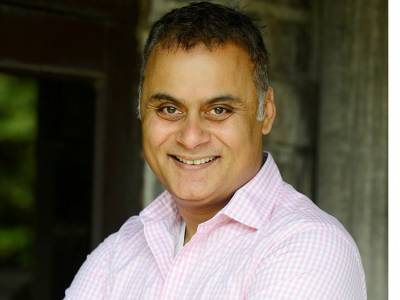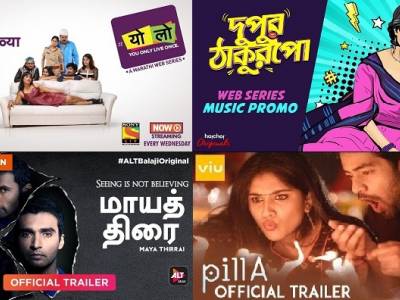Evolution in OTT space in India: Where next wave of growth will come from
The Over-the-top (OTT) space in India is emerging out of its linear TV shadow and getting its own band of subscribers. No longer is it a mere platform for catch-up shows or mini web-series. OTT players are coming up with compelling original content that is finding great traction with viewers.
Frost & Sullivan’s latest study reveals that the OTT video market in India is beginning to see real traction with more competitors and new innovative platforms on the back of cheaper data bundles. With 180.3 million active online video viewers and almost 4 million registered subscribers, the OTT video services market earned over Rs 37 billion in 2017, and is expected to grow at a CAGR of 17.3 per cent over the next five years.
The OTT video market in India is gradually becoming a mainstream entertainment destination with the rapid rise in the Internet user base and cheap smart devices which are now easily available across the globe.
Content genres like entertainment, sports, and regional are emerging as the key focus areas for the OTT platforms. Most of these players are at early stages of their maturity and are focusing on rapid consumer aggregation and driving engagement. From inception till now, the prime growth driver for OTT have been the unique stories.
The Growth Drivers
Uday Sodhi, EVP and Head-Digital Business, Sony Pictures Networks, noted, “Content consumption over the last 3-4 years has changed significantly on OTT platform. Our average consumption or time spent by the consumer on a single visit has gone up by almost 3 times in the last 2-3 years.”
Adding to this, Neeraj Roy, Managing Director and CEO, Hungama Digital Media, said that there are two factors that drive the growth of OTT. First is device and second is that one has access and connectivity. “If you look at the last 5 years in the evolution of devices, not just in India but across the globe players are getting into a ubiquitous device ecosystem. Today, across the globe there are 3 billion smartphones in the market in which Indian market itself adds 150 million smartphones and this spree will continue to grow in the future. Even when it comes to TV, in the last 2-3 years the evolution of smart TV has taken place, which means that we are no longer restricted to the content which you are getting through your set up box or cable but now you can get the content on web or an app to sample it.”Adding further he said, “The second thing which is driving this growth is access or connectivity. In the last 18-24 months, mainly, the markets have gone way cheap. You have smart devices to watch without worrying about the data price.”
Commenting on ALTBalaji’s success story, Nachiket Pantvaidya, Group COO and CEO ALTBalaji, explained, “We have seen our paid subscriber base triple in the last 100 days. This points out to a couple of trends – First, there is a rise in consumption of original and exclusive content on paid services. Second, there is validation of a paid subscriber led business model for OTT in India. This is largely because of the growth of video consumption on the Internet in the country and ALTBalaji’s ability to cater to local Indian audiences. As we stand today, we are the No. 1 repository for original and exclusive digital content in India.”
“Globally, the OTT space is going through continuous content innovation. However, in India the growth is much accelerated of late,” pointed out Manish Aggarwal, Chief Marketing Officer, ZEE5 India. He added that ZEE5 is the largest multilingual digital entertainment destination in the country with a premium content library. People today prefer entertainment on the go and are willing to experiment with new concepts and faces. Therefore, most major players in digital entertainment space are now extensively investing in exclusive original content across languages on the platforms.
Giving ZEE5’s example, Aggarwal said, “We have invested in a multitude of shows across languages – ‘Life Sahi Hai 2’, ‘Table Number 5’, ‘Dhatt Tere Ki’, ‘The Story’, ‘Tamashree’, and ‘Sone Bhi Do Yaaron’ in Hindi; ‘America Mapillai’ in Tamil; ‘Nanna Koochi’ in Telugu; ‘Mehmaan’ in Bengali; ‘Utsaha Itihasam’ in Malayalam; ‘Horn Ok Please’ in Marathi. In fact, we have released ‘Zero KMS’, the show that marks the digital debut of Naseeruddin Shah across 6 languages simultaneously as a first move in the OTT space.”
This, in addition to the boom seen in Internet penetration, smartphone ownership, mobile data consumption and seamless user experience at convenience have been the factors that have spurred on growth for OTT players.
Categories/ Genres That Really Work In OTT Space
As shared by ZEE5’s Aggarwal, “The Indian audience has always been a huge fan of content in the thriller, action and comedy genres. OTT being a space that is dominated by the young-at-heart audience, these genres get a fair amount of traction. A case in point being our recent addition to the platform – ‘Zero KMs’, a show that is dedicated to the issue of human trafficking and is the protagonist’s fight for justice. The show has received accolades and has been rated 9.6/10 by IMDB within just eight days of the launch. The show also marks the digital debut of Naseeruddin Shah as well as stars names like Tanmay Dhanania and Satyadeep Mishra.”
Continuing further, Aggarwal said that viewers today are preferring to binge-watch their favourite series on digital platforms vis-à-vis viewing by appointment. “Recognising this clear shift in preferences, platforms are bringing on their most popular soaps and series online. Another genre clearly making a mark is the original and dubbed version of international shows. Reflecting this, our recent additions, including ‘The Young Pope’ from the Hollywood drama series, ‘Pablo Escobar’, ‘Boys Over Flowers’ – a Korean drama, etc., provide a balance between both original content and catch-up TV.”
Neeraj Roy pointed out that in the entertainment genre, the first thing which has virality is humour and that’s why we see stand-ups as a genre. We see shows which are centred around friends, but with a strong overdose of humour. As a form factor, drama has always taken a very prominent genre.
Pantvaidya added here, “We feel that OTT consumption is driven by mobile phones and caters to individual viewing as opposed to family viewing. We have placed all our bets on linear fiction in our journey so far, to enable addictive and compulsive binge viewing of our content.”
“We have seen more consumption of live sports, catch-up TV and movies,” Uday Sodhi remarked.
How Viewership Perception Has Changed Over The Years
ALTBalaji’s Pantvaidya commented, “Today, we are in the early days of video consumption on Internet and there is no universal measurement system for hits and failures. This system does exist in TV today and therefore, there are parameters for measurement. From a consumer angle, as Internet has become more affordable and widespread, Indians are making conscious choices of what they want to watch and when. The mobile phone has become a second screen, but we are still a long way from cord cutting.”
He further stated, “The producer ecosystem for OTT thrives on multiple shows as show lengths are between 10 and 15 episodes today. From production perspective, the economics is dependent on efficiency of production and the availability of large talent pool that doesn’t want to get committed to the daily soap tradition.”
According to SPN’s Sodhi, “The basic movement that has happened for consumers now are that they watch content from multiple screens. It’s not just one screen, its multiple screens. People are ready to see watch on any screen which is available depending where they are. If they are home, they will love to watch it at TV but if somebody else is watching something on TV or while travelling they prefer watching the content on smaller screen. Because of connectivity, people have more opportunities to view content and thus the viewership is not just limited to TV but also they have another screen in front of them which they carry 24x7 with them which allow them to watch content when they want to.”Aggarwal felt that today, people are more inclined towards digital entertainment or ‘Entertainment on the go’, as viewing by appointment is on the wane. “Understanding this pattern shift, we, at ZEE5, started streaming our network television shows on the platform giving viewers the choice to watch it at their own convenience, anywhere.”
“Although this is an early trend in metros, more and more consumers are following the path of cord cutting and ditching their cable and satellite packages to embrace digital video platforms due to the width and depth of content available. The breadth of content with original content in regional languages, international shows, television shows and movies ensures that viewers across the spectrum have something here, an option they can choose at their own convenience,” he added.
The Growing Clout Of Regional
Regional content tends to be effective on the digital medium in the free TV ad-led space, Pantvaidya noted. Investments in high quality non-Hindi production are not justified in terms of revenues in the subscriber space today. Therefore, in the SVOD game, regional content is cost effective only if it can reach regional and diaspora audience. “We have created shows in Tamil (‘Maya Thirrai’) and Bengali (‘Dhimaner Dinkaal’) as well as regional shorts and are looking at a global strategy to expand our regional content offering, till then we are effectively targeting audience by dubbing content in Tamil, Telugu, Malayalam, bahasa and Malay,” he added.
Echoing with similar thoughts, Sodhi said that currently, regional has emerged as the new segment in digital entertainment on OTT platform. These days more and more have connectivity towards their smart TVs. Going forward, regional will become a large part of it.
Hungama’s Roy pointed out that if one looked at Indian Cinema, almost 34 per cent of Indian cinema box house was made up of 4 southern languages. “As a company, we have dealt with 400 partners in diverse markets, diverse languages and diverse culture. We will leverage this relationship now to give them a different form of platform,” he added.
Aggarwal observed, “Culturally, India has had a healthy appetite for regional entertainment, however it was unserved by OTT players. With Internet penetration in rural India booming, Tier 2 and 3 cities offer a huge untapped potential for innovative and exciting content.”
He further said, “Out of every 10 new digital Indians adopting the Internet, 9 are interested in language shows. Our content strategy for languages is two-pronged. One part of that mirrors the philosophy of the Group, focussing on the abundant language library content available from the channels and the other more interesting part is the exclusive Original shows that we are creating across languages. We have tasted tremendous success with regional originals, ‘Nanna Koochi’ in Tamil, ‘Mehmaan’ in West Bengal, etc.”
“With our extensive focus on content curated for regional markets, we are witnessing a large number of downloads in metros as well as language markets,” Aggarwal added.
The Next Wave in OTT
Pantvaidya foresees two trends: Firstly, ‘sachetization’ of pricing of SVOD services and secondly, the creation of the first digital daily in the next 12 months.
SPN’s Sodhi pointed out, “Today, OTT is reaching to 200-400 odd million users. Various reports suggest that these numbers will go ahead in the coming months and India will become the second largest digital video entertainment content consumer in the world after China.”
ZEE5’s Aggarwal noted that with the numbers of players in the OTT segment, innovation will be the name of the game to stay ahead. It is the best time to be a viewer as they have never been so spoilt for choice; and things are only just beginning to heat up.
The next change will revolve around bringing this experience alive. Thus, personalisation of this content, some of which is happening already; gamifying the content in an engaging manner; as also integrating technology enablers such as Augmented Reality and Virtual Reality, will be the game-changers. The platforms to do that successfully will clearly rule the roost.
With international tech giants investing heavily towards immersive technology, content in the OTT space cannot be far behind if we want to stay relevant.













Share
Facebook
YouTube
Tweet
Twitter
LinkedIn